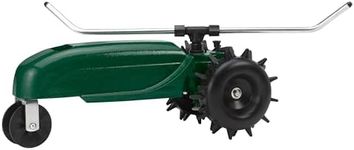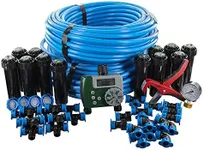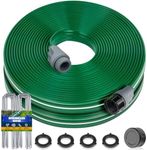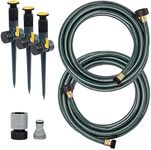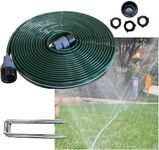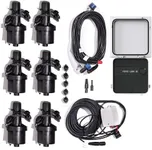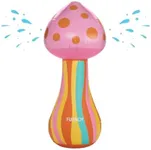Buying Guide for the Best Sprinkler Hoses
Choosing the right sprinkler hose for your garden or lawn can make a significant difference in the health and appearance of your plants. A sprinkler hose is designed to distribute water evenly over a large area, making it easier to maintain your garden without the need for manual watering. When selecting a sprinkler hose, it's important to consider several key specifications to ensure you get the best fit for your needs. Here are the main factors to consider and how to navigate them.LengthThe length of the sprinkler hose determines how much area it can cover. This is important because you want to ensure that the hose can reach all parts of your garden or lawn. Sprinkler hoses come in various lengths, typically ranging from 25 feet to 100 feet. If you have a small garden, a shorter hose may be sufficient. For larger areas, you may need a longer hose or multiple hoses connected together. Measure the area you need to water and choose a hose length that will cover it adequately.
MaterialThe material of the sprinkler hose affects its durability and flexibility. Common materials include rubber, vinyl, and reinforced plastic. Rubber hoses are generally more durable and can withstand higher water pressure, making them ideal for heavy-duty use. Vinyl hoses are lighter and more flexible, but they may not last as long as rubber hoses. Reinforced plastic hoses offer a balance between durability and flexibility. Consider how often you will use the hose and the conditions it will be exposed to when choosing the material.
Spray PatternThe spray pattern of a sprinkler hose determines how the water is distributed over your garden. Some hoses have a flat spray pattern, which is ideal for watering narrow strips of land, while others have a circular or oscillating pattern that covers a wider area. Think about the shape and size of your garden when selecting a spray pattern. If you have a rectangular garden, a flat spray pattern may be more efficient. For irregularly shaped or larger areas, a circular or oscillating pattern may be better.
Water Pressure CompatibilityDifferent sprinkler hoses are designed to operate at different water pressures. This is important because using a hose that is not compatible with your water pressure can result in poor performance or damage to the hose. Check the water pressure in your area and compare it to the recommended pressure range for the hose you are considering. Most residential water systems operate at a pressure of 30-50 psi (pounds per square inch), but it's always best to verify this before making a purchase.
Ease of UseEase of use includes factors such as how easy the hose is to set up, move, and store. Some hoses come with features like quick-connect fittings, which make it easier to attach and detach the hose from the water source. Others may have built-in reels or storage solutions to keep the hose organized when not in use. Consider your physical capabilities and how often you will need to move the hose around your garden. A hose that is lightweight and easy to handle can make your gardening tasks much more manageable.
AdjustabilityAdjustability refers to the ability to control the water flow and spray pattern of the hose. Some sprinkler hoses come with adjustable nozzles or valves that allow you to customize the water output to suit different plants and areas of your garden. This is important because different plants have different watering needs, and being able to adjust the hose can help you provide the right amount of water to each area. Look for hoses with adjustable features if you have a diverse garden with varying watering requirements.
